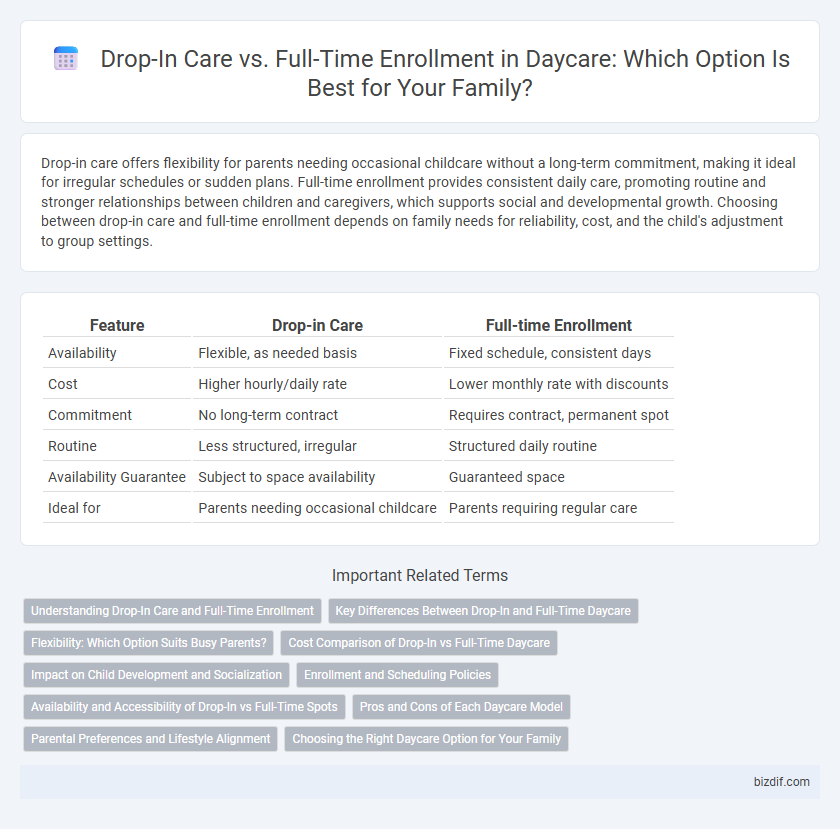Drop-in care offers flexibility for parents needing occasional childcare without a long-term commitment, making it ideal for irregular schedules or sudden plans. Full-time enrollment provides consistent daily care, promoting routine and stronger relationships between children and caregivers, which supports social and developmental growth. Choosing between drop-in care and full-time enrollment depends on family needs for reliability, cost, and the child's adjustment to group settings.
Table of Comparison
| Feature | Drop-in Care | Full-time Enrollment |
|---|---|---|
| Availability | Flexible, as needed basis | Fixed schedule, consistent days |
| Cost | Higher hourly/daily rate | Lower monthly rate with discounts |
| Commitment | No long-term contract | Requires contract, permanent spot |
| Routine | Less structured, irregular | Structured daily routine |
| Availability Guarantee | Subject to space availability | Guaranteed space |
| Ideal for | Parents needing occasional childcare | Parents requiring regular care |
Understanding Drop-In Care and Full-Time Enrollment
Drop-in care offers flexible, short-term childcare options, ideal for parents needing occasional support without a long-term commitment. Full-time enrollment provides consistent, scheduled care fostering routine and social development for children. Understanding these options helps parents choose based on their availability, childcare needs, and budget considerations.
Key Differences Between Drop-In and Full-Time Daycare
Drop-in care offers flexible, as-needed childcare without long-term commitments, ideal for parents requiring occasional support, whereas full-time enrollment provides consistent, scheduled care with structured routines fostering child development. Drop-in care typically has higher per-hour costs but lower overall expenditure due to irregular use, while full-time daycare is cost-effective for continual attendance and includes benefits like socialization and educational programs. Understanding these key differences helps parents choose childcare arrangements that best suit their schedules, budgets, and children's needs.
Flexibility: Which Option Suits Busy Parents?
Drop-in care offers unmatched flexibility for busy parents who need occasional, short-term childcare without long-term commitments. Full-time enrollment ensures consistent scheduling and routine, ideal for families requiring regular, daily care. Parents balancing unpredictable work hours or sudden appointments often prefer drop-in services, while those seeking stability benefit from full-time daycare programs.
Cost Comparison of Drop-In vs Full-Time Daycare
Drop-in daycare typically charges higher hourly rates compared to full-time enrollment, making it less cost-effective for families needing regular care. Full-time enrollment offers lower per-day rates and often includes additional benefits such as meals and educational activities, providing better overall value. Parents should evaluate their childcare needs and frequency to determine whether paying premium drop-in fees or committing to a full-time schedule better suits their budget.
Impact on Child Development and Socialization
Drop-in care offers flexible, short-term interaction opportunities that can help children adjust to social environments and develop adaptability skills. Full-time enrollment provides consistent routines and prolonged peer interaction, fostering deeper social bonds and more structured developmental progress. Both care types influence child development uniquely, with drop-in care supporting social experimentation and full-time enrollment enhancing stability and comprehensive skill-building.
Enrollment and Scheduling Policies
Drop-in care offers flexible enrollment and scheduling policies, allowing parents to reserve care on an as-needed basis without long-term commitments. Full-time enrollment requires consistent attendance, often involving set schedules and contractual agreements that guarantee a regular spot. Daycares typically provide clear guidelines on cancellation, availability, and priority for full-time enrolled children over drop-in participants.
Availability and Accessibility of Drop-In vs Full-Time Spots
Drop-in care offers flexible availability for parents needing occasional or irregular child care, making it accessible without long-term commitments or waitlists common in full-time enrollment. Full-time spots often require advance registration and may have limited availability due to higher demand and capacity constraints, reducing immediate accessibility. Choosing drop-in care supports spontaneous scheduling needs, while full-time enrollment ensures consistent daily attendance but with less flexibility in spot availability.
Pros and Cons of Each Daycare Model
Drop-in care offers flexibility for parents needing occasional childcare without long-term commitment, though it may lack consistency and routine beneficial for child development. Full-time enrollment provides stable schedules and structured learning environments, enhancing socialization and skill-building, but often involves higher costs and less scheduling flexibility. Choosing between these models depends on balancing the need for convenience with the importance of consistent care and developmental support.
Parental Preferences and Lifestyle Alignment
Parental preferences for drop-in care versus full-time enrollment often hinge on lifestyle alignment and flexibility needs, with drop-in care appealing to parents who require occasional, adaptable childcare due to irregular work schedules or spontaneous commitments. Full-time enrollment suits families seeking consistent routines and structured environments that support steady development and socialization for their children. Understanding these preferences helps daycare centers tailor programs to meet diverse family demands and improve overall satisfaction.
Choosing the Right Daycare Option for Your Family
Drop-in care provides flexibility for families needing occasional childcare without long-term commitments, ideal for parents with irregular schedules or temporary needs. Full-time enrollment offers consistent daily care, fostering routine and social development through regular interactions with peers and caregivers. Evaluating your family's schedule, budget, and childcare goals helps determine whether drop-in options or full-time enrollment better supports your child's growth and your household's lifestyle.
Drop-in care vs full-time enrollment Infographic

 bizdif.com
bizdif.com